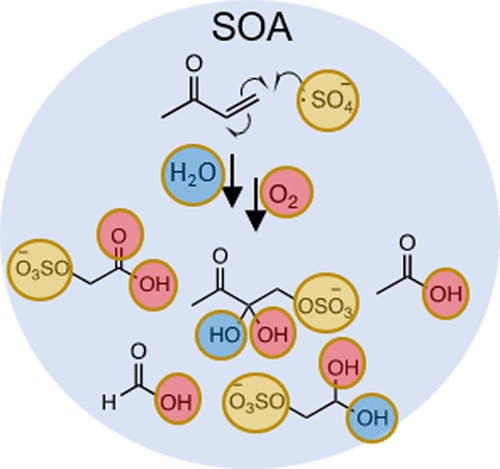当前位置:
X-MOL 学术
›
Environ. Sci. Technol.
›
论文详情
Our official English website, www.x-mol.net, welcomes your
feedback! (Note: you will need to create a separate account there.)
General Mechanism for Sulfate Radical Addition to Olefinic Volatile Organic Compounds in Secondary Organic Aerosol
Environmental Science & Technology ( IF 10.8 ) Pub Date : 2021-01-21 , DOI: 10.1021/acs.est.0c05256 He Ren 1 , Jane A. Sedlak 1 , Matthew J. Elrod 1
Environmental Science & Technology ( IF 10.8 ) Pub Date : 2021-01-21 , DOI: 10.1021/acs.est.0c05256 He Ren 1 , Jane A. Sedlak 1 , Matthew J. Elrod 1
Affiliation

|
Previous laboratory studies have suggested that sulfate radical addition to olefinic biogenic volatile organic compounds (BVOCs) is a potential formation mechanism for some organosulfates detected in ambient secondary organic aerosol (SOA). However, these studies propose conflicting reaction products, possibly because laboratory dissolved oxygen levels did not accurately reflect atmospheric conditions. Additionally, these studies used analytical methods that could not definitively identify and quantify the structurally specific products. Here, we describe a method that allows for the study of the reaction of sulfate radicals and several olefinic precursors, including allyl alcohol (AA), methyl vinyl ketone (MVK), 2-methyl-3-buten-2-ol (MBO), and methacrolein (MA), with careful control of dissolved oxygen levels and using the isomer-specific nuclear magnetic resonance (NMR) method to definitively identify and quantify the reaction products. Specific mechanisms for each olefinic precursor were developed, as well as a generalized mechanism that can be used to predict the sulfate radical reaction pathways for any olefin. The product yield results indicate that this mechanism is dominated by carbon backbone fragmentation pathways: 61, 83, 79, and 100% for AA, MVK, MBO, and MA, respectively. Several of the observed organosulfate products have also been detected in field observations of SOA, which indicates the potential relevance of this mechanism in the atmosphere.
中文翻译:

在次级有机气溶胶中向自由基挥发性有机化合物加硫酸根的一般机理
以前的实验室研究表明,将硫酸根添加到烯属生物挥发性有机化合物(BVOC)中是在环境二次有机气溶胶(SOA)中检测到的某些有机硫酸盐的潜在形成机理。但是,这些研究提出了相互矛盾的反应产物,可能是因为实验室溶解氧水平不能准确反映大气条件。此外,这些研究使用的分析方法无法确切地识别和量化特定结构的产品。在这里,我们描述了一种方法,该方法可以研究硫酸根和几种烯属前体的反应,包括烯丙醇(AA),甲基乙烯基酮(MVK),2-甲基-3-丁烯-2-醇(MBO) ,以及甲基丙烯醛(MA),仔细控制溶解氧水平,并使用异构体特异性核磁共振(NMR)方法确定和量化反应产物。开发了每种烯烃前体的具体机理,以及可以用于预测任何烯烃的硫酸根自由基反应途径的通用机理。产品收率结果表明,该机制由碳骨架断裂途径主导:AA,MVK,MBO和MA分别为61%,83%,79%和100%。在SOA的现场观察中还检测到了几种观察到的有机硫酸盐产物,这表明了这种机制在大气中的潜在相关性。开发了每种烯烃前体的具体机理,以及可以用于预测任何烯烃的硫酸根自由基反应途径的通用机理。产品收率结果表明,该机制由碳骨架断裂途径主导:AA,MVK,MBO和MA分别为61%,83%,79%和100%。在SOA的现场观察中还检测到了几种观察到的有机硫酸盐产物,这表明了这种机制在大气中的潜在相关性。开发了每种烯烃前体的具体机理,以及可以用于预测任何烯烃的硫酸根自由基反应途径的通用机理。产品收率结果表明,该机制由碳骨架断裂途径主导:AA,MVK,MBO和MA分别为61%,83%,79%和100%。在SOA的现场观察中还检测到了几种观察到的有机硫酸盐产物,这表明了这种机制在大气中的潜在相关性。
更新日期:2021-02-02
中文翻译:

在次级有机气溶胶中向自由基挥发性有机化合物加硫酸根的一般机理
以前的实验室研究表明,将硫酸根添加到烯属生物挥发性有机化合物(BVOC)中是在环境二次有机气溶胶(SOA)中检测到的某些有机硫酸盐的潜在形成机理。但是,这些研究提出了相互矛盾的反应产物,可能是因为实验室溶解氧水平不能准确反映大气条件。此外,这些研究使用的分析方法无法确切地识别和量化特定结构的产品。在这里,我们描述了一种方法,该方法可以研究硫酸根和几种烯属前体的反应,包括烯丙醇(AA),甲基乙烯基酮(MVK),2-甲基-3-丁烯-2-醇(MBO) ,以及甲基丙烯醛(MA),仔细控制溶解氧水平,并使用异构体特异性核磁共振(NMR)方法确定和量化反应产物。开发了每种烯烃前体的具体机理,以及可以用于预测任何烯烃的硫酸根自由基反应途径的通用机理。产品收率结果表明,该机制由碳骨架断裂途径主导:AA,MVK,MBO和MA分别为61%,83%,79%和100%。在SOA的现场观察中还检测到了几种观察到的有机硫酸盐产物,这表明了这种机制在大气中的潜在相关性。开发了每种烯烃前体的具体机理,以及可以用于预测任何烯烃的硫酸根自由基反应途径的通用机理。产品收率结果表明,该机制由碳骨架断裂途径主导:AA,MVK,MBO和MA分别为61%,83%,79%和100%。在SOA的现场观察中还检测到了几种观察到的有机硫酸盐产物,这表明了这种机制在大气中的潜在相关性。开发了每种烯烃前体的具体机理,以及可以用于预测任何烯烃的硫酸根自由基反应途径的通用机理。产品收率结果表明,该机制由碳骨架断裂途径主导:AA,MVK,MBO和MA分别为61%,83%,79%和100%。在SOA的现场观察中还检测到了几种观察到的有机硫酸盐产物,这表明了这种机制在大气中的潜在相关性。











































 京公网安备 11010802027423号
京公网安备 11010802027423号